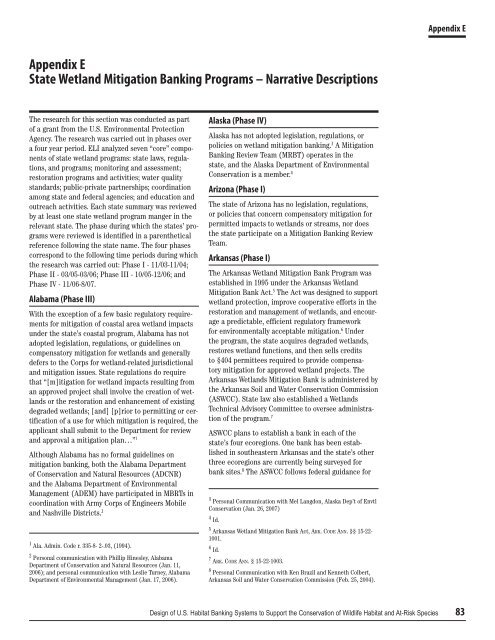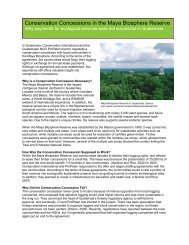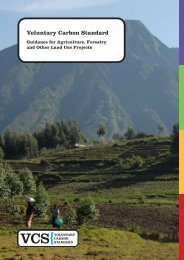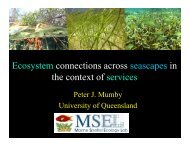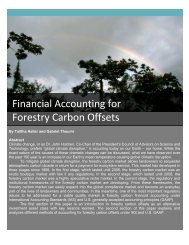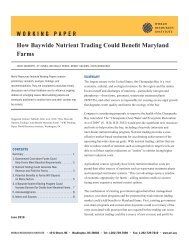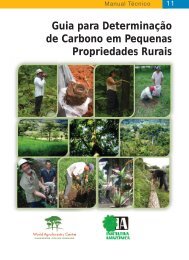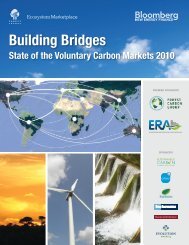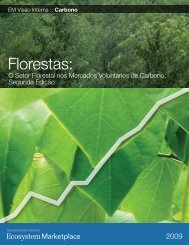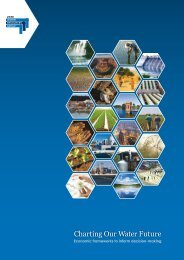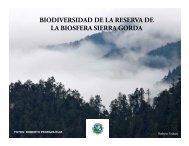Design of US Habitat Banking Systems to Support the Conservation ...
Design of US Habitat Banking Systems to Support the Conservation ...
Design of US Habitat Banking Systems to Support the Conservation ...
You also want an ePaper? Increase the reach of your titles
YUMPU automatically turns print PDFs into web optimized ePapers that Google loves.
Appendix EAppendix EState Wetland Mitigation <strong>Banking</strong> Programs – Narrative DescriptionsThe research for this section was conducted as part<strong>of</strong> a grant from <strong>the</strong> U.S. Environmental ProtectionAgency. The research was carried out in phases overa four year period. ELI analyzed seven “core” components<strong>of</strong> state wetland programs: state laws, regulations,and programs; moni<strong>to</strong>ring and assessment;res<strong>to</strong>ration programs and activities; water qualitystandards; public-private partnerships; coordinationamong state and federal agencies; and education andoutreach activities. Each state summary was reviewedby at least one state wetland program manger in <strong>the</strong>relevant state. The phase during which <strong>the</strong> states’ programswere reviewed is identified in a paren<strong>the</strong>ticalreference following <strong>the</strong> state name. The four phasescorrespond <strong>to</strong> <strong>the</strong> following time periods during which<strong>the</strong> research was carried out: Phase I - 11/03-11/04;Phase II - 03/05-03/06; Phase III - 10/05-12/06; andPhase IV - 11/06-8/07.Alabama (Phase III)With <strong>the</strong> exception <strong>of</strong> a few basic regula<strong>to</strong>ry requirementsfor mitigation <strong>of</strong> coastal area wetland impactsunder <strong>the</strong> state’s coastal program, Alabama has notadopted legislation, regulations, or guidelines oncompensa<strong>to</strong>ry mitigation for wetlands and generallydefers <strong>to</strong> <strong>the</strong> Corps for wetland-related jurisdictionaland mitigation issues. State regulations do requirethat “[m]itigation for wetland impacts resulting froman approved project shall involve <strong>the</strong> creation <strong>of</strong> wetlandsor <strong>the</strong> res<strong>to</strong>ration and enhancement <strong>of</strong> existingdegraded wetlands; [and] [p]rior <strong>to</strong> permitting or certification<strong>of</strong> a use for which mitigation is required, <strong>the</strong>applicant shall submit <strong>to</strong> <strong>the</strong> Department for reviewand approval a mitigation plan…” 1Although Alabama has no formal guidelines onmitigation banking, both <strong>the</strong> Alabama Department<strong>of</strong> <strong>Conservation</strong> and Natural Resources (ADCNR)and <strong>the</strong> Alabama Department <strong>of</strong> EnvironmentalManagement (ADEM) have participated in MBRTs incoordination with Army Corps <strong>of</strong> Engineers Mobileand Nashville Districts. 21 Ala. Admin. Code r. 335-8- 2-.03, (1994).2 Personal communication with Phillip Hinesley, AlabamaDepartment <strong>of</strong> <strong>Conservation</strong> and Natural Resources (Jan. 11,2006); and personal communication with Leslie Turney, AlabamaDepartment <strong>of</strong> Environmental Management (Jan. 17, 2006).Alaska (Phase IV)Alaska has not adopted legislation, regulations, orpolicies on wetland mitigation banking. 3 A Mitigation<strong>Banking</strong> Review Team (MRBT) operates in <strong>the</strong>state, and <strong>the</strong> Alaska Department <strong>of</strong> Environmental<strong>Conservation</strong> is a member. 4Arizona (Phase I)The state <strong>of</strong> Arizona has no legislation, regulations,or policies that concern compensa<strong>to</strong>ry mitigation forpermitted impacts <strong>to</strong> wetlands or streams, nor does<strong>the</strong> state participate on a Mitigation <strong>Banking</strong> ReviewTeam.Arkansas (Phase I)The Arkansas Wetland Mitigation Bank Program wasestablished in 1995 under <strong>the</strong> Arkansas WetlandMitigation Bank Act. 5 The Act was designed <strong>to</strong> supportwetland protection, improve cooperative efforts in <strong>the</strong>res<strong>to</strong>ration and management <strong>of</strong> wetlands, and encouragea predictable, efficient regula<strong>to</strong>ry frameworkfor environmentally acceptable mitigation. 6 Under<strong>the</strong> program, <strong>the</strong> state acquires degraded wetlands,res<strong>to</strong>res wetland functions, and <strong>the</strong>n sells credits<strong>to</strong> §404 permittees required <strong>to</strong> provide compensa<strong>to</strong>rymitigation for approved wetland projects. TheArkansas Wetlands Mitigation Bank is administered by<strong>the</strong> Arkansas Soil and Water <strong>Conservation</strong> Commission(ASWCC). State law also established a WetlandsTechnical Advisory Committee <strong>to</strong> oversee administration<strong>of</strong> <strong>the</strong> program. 7ASWCC plans <strong>to</strong> establish a bank in each <strong>of</strong> <strong>the</strong>state’s four ecoregions. One bank has been establishedin sou<strong>the</strong>astern Arkansas and <strong>the</strong> state’s o<strong>the</strong>rthree ecoregions are currently being surveyed forbank sites. 8 The ASWCC follows federal guidance for3 Personal Communication with Mel Langdon, Alaska Dep’t <strong>of</strong> Envtl<strong>Conservation</strong> (Jan. 26, 2007)4 Id.5 Arkansas Wetland Mitigation Bank Act, ARK. CODE ANN. §§ 15-22-1001.6 Id.7 ARK. CODE ANN. § 15-22-1003.8 Personal Communication with Ken Brazil and Kenneth Colbert,Arkansas Soil and Water <strong>Conservation</strong> Commission (Feb. 25, 2004).<strong>Design</strong> <strong>of</strong> U.S. <strong>Habitat</strong> <strong>Banking</strong> <strong>Systems</strong> <strong>to</strong> <strong>Support</strong> <strong>the</strong> <strong>Conservation</strong> <strong>of</strong> Wildlife <strong>Habitat</strong> and At-Risk Species 83


